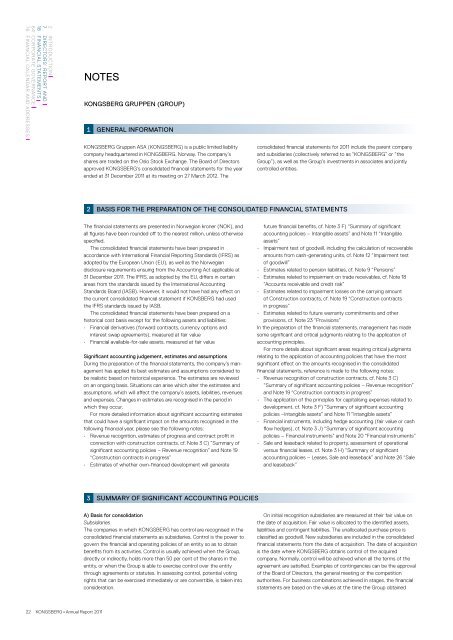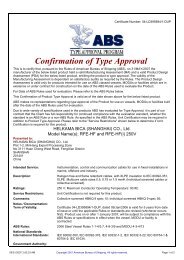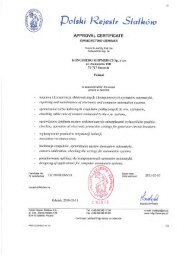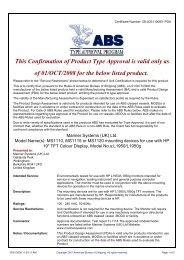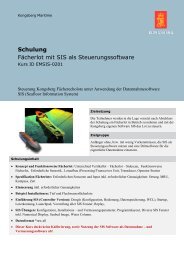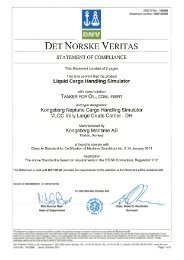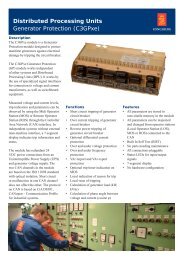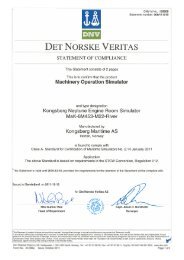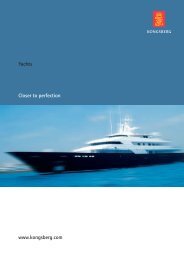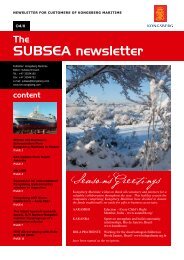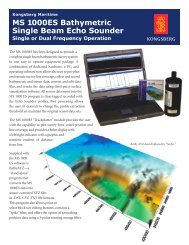Annual Report 2011 - Kongsberg Maritime - Kongsberg Gruppen
Annual Report 2011 - Kongsberg Maritime - Kongsberg Gruppen
Annual Report 2011 - Kongsberg Maritime - Kongsberg Gruppen
Create successful ePaper yourself
Turn your PDF publications into a flip-book with our unique Google optimized e-Paper software.
2 INTRODUCTION<br />
7 DIRECTORS’ REPORT AND<br />
18 FINANCIAL STATEMENTS<br />
64 CORPORATE GOVERNANCE<br />
76 FINANCIAL CALENDAR AND ADDRESSES<br />
NOTES<br />
22 KONGSBERG <strong>Annual</strong> <strong>Report</strong> <strong>2011</strong><br />
KONGSBERG GRUPPEN (GROUP)<br />
1<br />
GENERAL INFORMATION<br />
KONGSBERG <strong>Gruppen</strong> ASA (KONGSBERG) is a public limited liability<br />
company headquartered in KONGSBERG, Norway. The company’s<br />
shares are traded on the Oslo Stock Exchange. The Board of Directors<br />
approved KONGSBERG’s consolidated financial statements for the year<br />
ended at 31 December <strong>2011</strong> at its meeting on 27 March 2012. The<br />
2<br />
The financial statements are presented in Norwegian kroner (NOK), and<br />
all figures have been rounded off to the nearest million, unless otherwise<br />
specified.<br />
The consolidated financial statements have been prepared in<br />
ac cordance with International Financial <strong>Report</strong>ing Standards (IFRS) as<br />
adopted by the European Union (EU), as well as the Norwegian<br />
disclosure requirements ensuing from the Accounting Act applicable at<br />
31 December <strong>2011</strong>. The IFRS, as adopted by the EU, differs in certain<br />
areas from the standards issued by the International Accounting<br />
Standards Board (IASB). However, it would not have had any effect on<br />
the current consolidated financial statement if KONSBERG had used<br />
the IFRS standards issued by IASB.<br />
The consolidated financial statements have been prepared on a<br />
historical cost basis except for the following assets and liabilities:<br />
• Financial derivatives (forward contracts, currency options and<br />
interest swap agreements), measured at fair value<br />
• Financial available-for-sale assets, measured at fair value<br />
Significant accounting judgement, estimates and assumptions<br />
During the preparation of the financial statements, the company’s management<br />
has applied its best estimates and assumptions considered to<br />
be realistic based on historical experience. The estimates are reviewed<br />
on an ongoing basis. Situations can arise which alter the estimates and<br />
assumptions, which will affect the company’s assets, liabilities, revenues<br />
and expenses. Changes in estimates are recognised in the period in<br />
which they occur.<br />
For more detailed information about significant accounting estimates<br />
that could have a significant impact on the amounts recognised in the<br />
following financial year, please see the following notes:<br />
• Revenue recognition, estimates of progress and contract profit in<br />
connection with construction contracts, cf. Note 3 C) “Summary of<br />
significant accounting policies – Revenue recognition” and Note 19<br />
“Construction contracts in progress”<br />
• Estimates of whether own-financed development will generate<br />
3<br />
SUMMARY OF SIGNIFICANT ACCOUNTING POLICIES<br />
A) Basis for consolidation<br />
Subsidiaries<br />
The companies in which KONGSBERG has control are recognised in the<br />
consolidated financial statements as subsidiaries. Control is the power to<br />
govern the financial and operating policies of an entity so as to obtain<br />
benefits from its activities. Control is usually achieved when the Group,<br />
directly or indirectly, holds more than 50 per cent of the shares in the<br />
entity, or when the Group is able to exercise control over the entity<br />
through agreements or statutes. In assessing control, potential voting<br />
rights that can be exercised immediately or are convertible, is taken into<br />
consideration.<br />
consolidated financial statements for <strong>2011</strong> include the parent company<br />
and subsidiaries (collectively referred to as “KONGSBERG” or “the<br />
Group”), as well as the Group’s investments in associates and jointly<br />
controlled entities.<br />
BASIS FOR THE PREPARATION OF THE CONSOLIDATED FINANCIAL STATEMENTS<br />
future financial benefits, cf. Note 3 F) “Summary of significant<br />
accounting policies – Intangible assets” and Note 11 “Intangible<br />
assets”<br />
• Impairment test of goodwill, including the calculation of recoverable<br />
amounts from cash-generating units, cf. Note 12 “Impairment test<br />
of goodwill”<br />
• Estimates related to pension liabilities, cf. Note 9 “Pensions”<br />
• Estimates related to impairment on trade receivables, cf. Note 18<br />
“Accounts receivable and credit risk”<br />
• Estimates related to impairment losses on the carrying amount<br />
of Construction contracts, cf. Note 19 “Construction contracts<br />
in progress”<br />
• Estimates related to future warranty commitments and other<br />
provisions, cf. Note 23 “Provisions”<br />
In the preparation of the financial statements, management has made<br />
some significant and critical judgments relating to the application of<br />
accounting principles.<br />
For more details about significant areas requiring critical judgments<br />
relating to the application of accounting policies that have the most<br />
significant effect on the amounts recognised in the consolidated<br />
financial statements, reference is made to the following notes:<br />
• Revenue recognition of construction contracts, cf. Note 3 C)<br />
“Summary of significant accounting policies – Revenue recognition”<br />
and Note 19 “Construction contracts in progress”<br />
• The application of the principles for capitalising expenses related to<br />
development, cf. Note 3 F) “Summary of significant accounting<br />
policies –Intangible assets” and Note 11 “Intangible assets”<br />
• Financial instruments, including hedge accounting (fair value or cash<br />
flow hedges), cf. Note 3 J) “Summary of significant accounting<br />
policies – Financial instruments” and Note 20 “Financial instruments”<br />
• Sale and leaseback related to property, assessment of operational<br />
versus financial leases, cf. Note 3 H) “Summary of significant<br />
accounting policies – Leases, Sale and leaseback” and Note 26 “Sale<br />
and leaseback”<br />
On initial recognition subsidiaries are measured at their fair value on<br />
the date of acquisition. Fair value is allocated to the identified assets,<br />
liabilities and contingent liabilities. The unallocated purchase price is<br />
classified as goodwill. New subsidiaries are included in the consolidated<br />
financial statements from the date of acquisition. The date of acquisition<br />
is the date where KONGSBERG obtains control of the acquired<br />
company. Normally, control will be achieved when all the terms of the<br />
agreement are satisfied. Examples of contingencies can be the approval<br />
of the Board of Directors, the general meeting or the competition<br />
authorities. For business combinations achieved in stages, the financial<br />
statements are based on the values at the time the Group obtained


